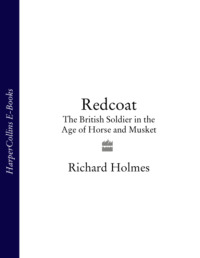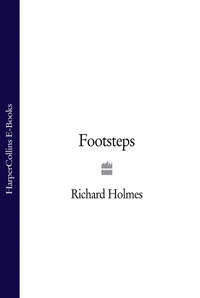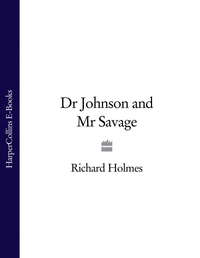
Полная версия
Sahib: The British Soldier in India 1750–1914

Sahib
The British Soldier In India 1750-1914
Richard Holmes
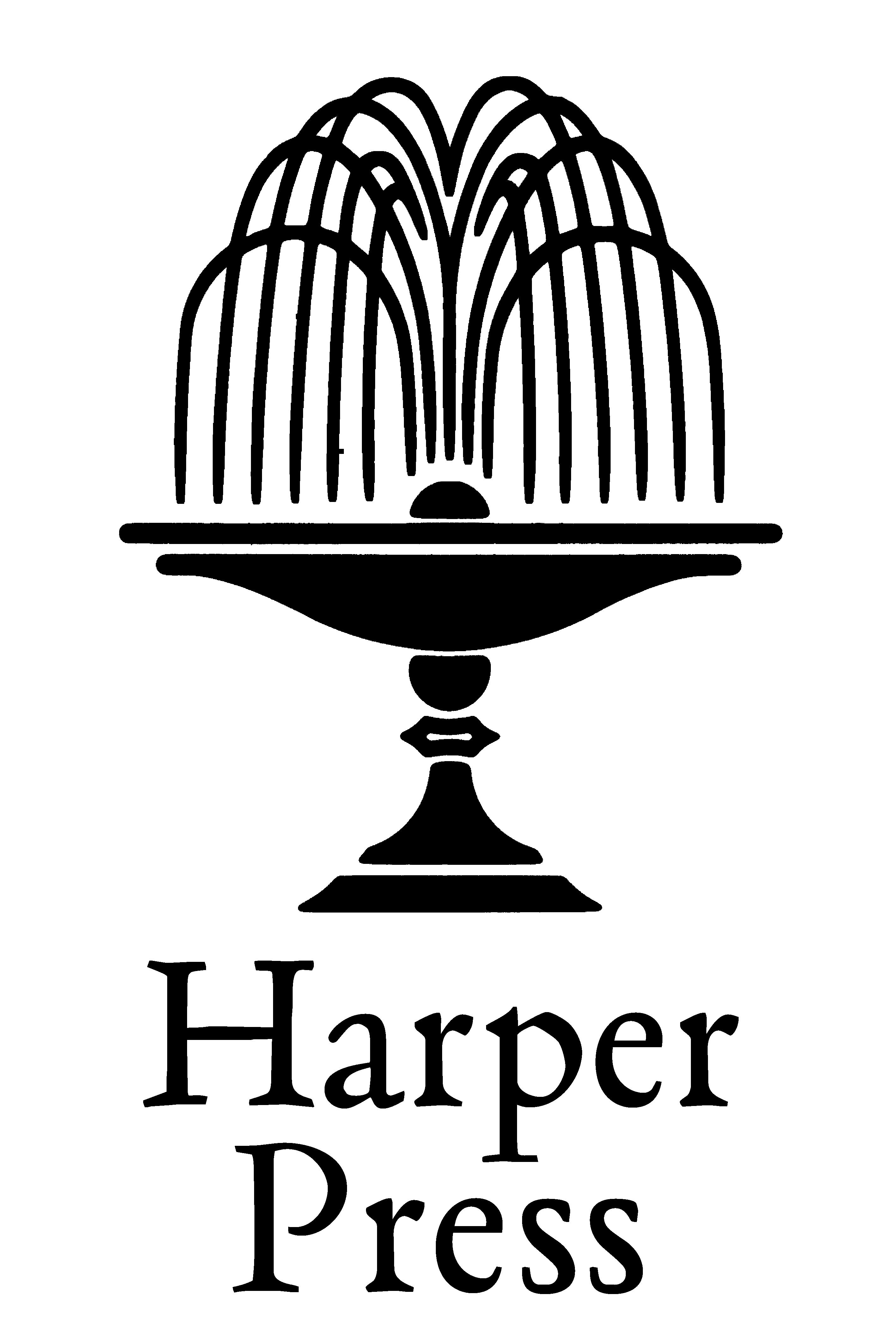
To Lizzie, Jessica and Corinna, the women in my life
Table of Contents
Cover Page
Title Page
Dedication
Maps
Epigraph
INTRODUCTION
PROLOGUE
I IN INDIA’S SUNNY CLIME
THE LAND OF THE PAGODA TREE
EMPIRES RISE AND WANE
THE HONOURABLE COMPANY
‘THE DEVIL’S WIND’
THE BRITISH RAJ
II THE TROOPSHIPS BRING US
A PASSAGE TO INDIA
SOMETHING STRANGE TO US ALL
SUDDER AND MOFUSSIL
BARRACKS AND BUNGALOWS
CALLING CARDS AND DRAWING ROOMS
BOREDOM AND BAT
III BREAD AND SALT
LORDS OF WAR
SOLDIERS WITHOUT REGIMENTS
HORSE, FOOT AND GUNS
SALT AND GOLD
IV THE SMOKE OF THE FUSILLADE
FIELDS OF BATTLE
BROTHERS IN ARMS?
GOLD EPAULETTES, SILVER MEDALS
DASH AT THE FIRST PARTY
SHOT AND SHELL
BLACK POWDER AND COLD STEEL
BOOT AND SADDLE
THE PETTAH WALL
DUST AND BLOOD
V INDIA’S EXILES
ARRACK AND THE LASH
BIBIS AND MEMSAHIBS
CHRISTIAN SOLDIERS
A FAMILIAR FRIEND
HOT BLOOD, BAD BLOOD
A NOBLE WIFE
EPILOGUE
GLOSSARY OF INDIAN TERMS
Bibliography
ACKNOWLEGDGEMENTS
NOTES
INDEX
P.S.
About the author
About the book
Read on
About the Author
Praise
ALSO BY RICHARD HOLMES
Copyright
About the Publisher
MAPS
The Indian sub-continent
Punjab and the North-West Frontier
Bengal
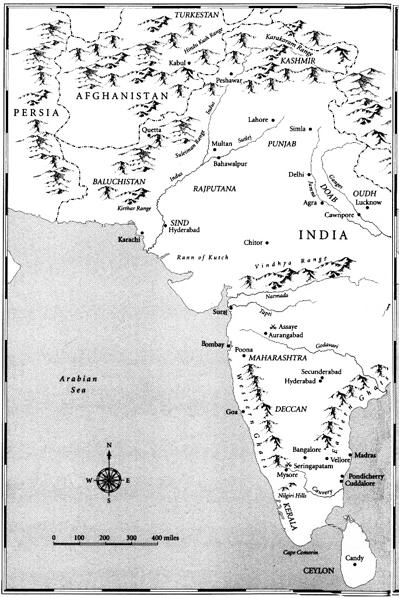

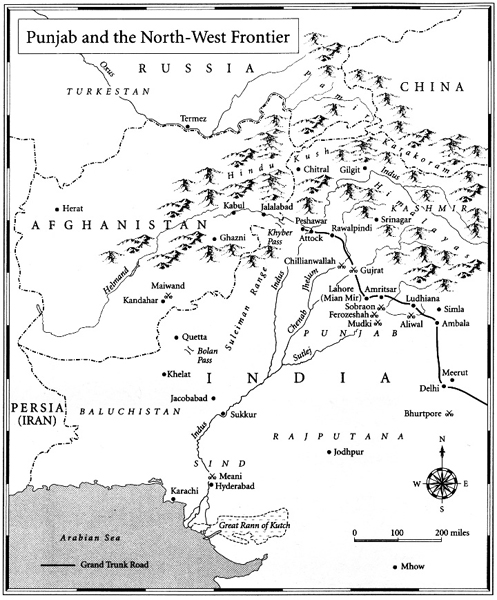
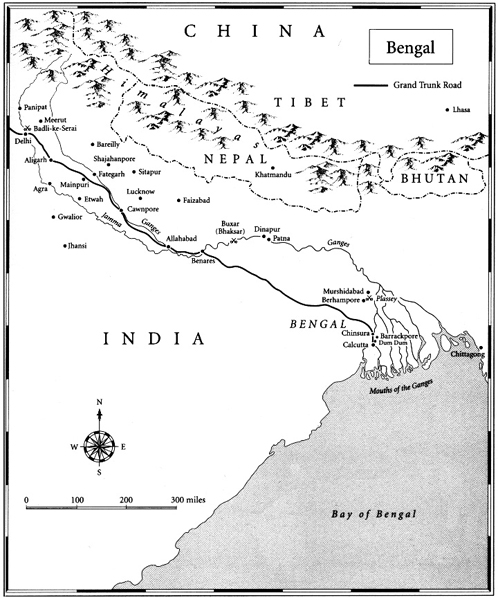
Riding through the densely packed bazaars of Bareilly City on Judy, my mare, passing village temples, cantering across the magical plains that stretched away to the Himalayas, I shivered at the millions and immensities and secrecies of India. I liked to finish my day at the club, in a world whose limits were known and where people answered my beck. An incandescent lamp coughed its light over shrivelled grass and dusty shrubbery; in its circle of illumination exiled heads were bent over English newspapers, their thoughts far away, but close to mine. Outside, people prayed and plotted and mated and died on a scale unimaginable and uncomfortable. We English were a caste. White overlords or whiter monkeys – it was all the same. The Brahmins made a circle within which they cooked their food. So did we. We were a caste: pariahs to them, princes in our own estimation.
F. YEATS-BROWN, Bengal Lancer
INTRODUCTION
Like it or not, the British conquest and dominion of India is one of history’s great epics. A vast, populous and geographically varied continent half a world away from these islands was dominated for over 300 years by a relatively small number of British. It is no exaggeration to say that India was indeed the ‘jewel in the crown’ of the Empire, with a unique place in public and official estimation in general and in the history of the British army in particular. ‘The British conquered India by military force,’ proclaimed the distinguished Indian civil servant Sir Penderel Moon, ‘and the campaigns and battles by which this was achieved … were historical events without which Britain’s Indian empire would never have come into existence.’1
It is remarkable to see how much was accomplished by so few. When Queen Victoria came to the throne in 1837, the European population living in India numbered around 41,000, about 37,000 of whom were soldiers; another 1,000 worked for the Indian Civil Service and about another 30,000 of the population was of racially mixed parentage. There was a native population of at least 15 million, less than 200,000 of whom served in the army of the Honourable East India Company, the commercial corporation which, in what is perhaps the most striking example of the flag following trade, actually ran the subcontinent until the British government assumed its responsibilities in 1858.
Historians are unsure whether British rule was a good thing or a bad thing, with two real heavyweights in the debate having disputed the matter recently. In Empire: The Rise and Demise of the British World Order, Niall Ferguson declared that: ‘The question is not whether British imperialism was without blemish. It was not. The question is whether there could have been a less bloody path to modernity.’ His answer is generally negative, arguing that the Empire brought ‘free markets, the rule of law … and relatively incorrupt government’.2 Linda Colley is rather less admiring. In Captives: Britain, Empire and the World, she identifies a strong undercurrent of imperial racism, not least amongst the ‘poor whites’ who provided the shock troops of Empire.3 There is little unanimity amongst Indian historians, for while some look upon the whole imperial episode as an obnoxious aberration, others see value and an enduring benevolent legacy in the British contribution. The Indian historian Kusoom Vadgama writes that ‘independent India is richer for the railways, the telegraphic systems, education, legal and parliamentary procedures based on the British models’ and suggests that it was in fact the Quit India movement of 1942 that pushed Britain towards premature withdrawal and partition. 4 But as Moon observed, while the Empire ‘has been both lauded and execrated with undiscriminating fervour – its establishment was an achievement that ought to excite wonder’.5
And so this is neither a book about the rights or wrongs of the Indian Empire, nor a history of its rise and fall (for the latter Lawrence James’s Raj: The Making and Unmaking of British India stands pre-eminent as a readable popular survey). Instead, I seek to illuminate the central paradox of the Raj: how did a relatively small number of British soldiers gain and retain control of the subcontinent? What encouraged them to go to India; what did they make of an environment so very different to their own; how did they live there and, no less to the point, how did they die?
I have chosen to start my narrative proper in 1750, just before the first major battles which gave the British control of Bengal, and on the eve of the arrival in India of large formed bodies of British infantry. I have selected 1914 as my cut-off date for a variety of reasons. While dates rarely mark abrupt historical watersheds (and in many ways the India of 1920 had very much in common with the India of 1910), the experience of the First World War marked British and Indian soldiers alike; the Indianisation of the Indian army was fast becoming a major military policy issue; and popular historiography, its trail blazed by Charles Allen’s Plain Tales from the Raj, is at its strongest for the period 1914–47. Much as I would like to consider the experience of the British soldier in India over this latter period, this is not the book in which to do it.
As Colonel Henry Yule and Dr A. C. Burnell tell us in Hobson-Jobson, that glossary of Anglo-Indian words which no historian should be without, ‘sahib’ was ‘the title by which … European gentlemen, and it may be said Europeans generally, are addressed, and spoken of, when no disrespect is intended, by natives’. It was affixed to the name or office, ‘corresponding thus rather to Monsieur than to Mr’, to produce Colonel Sahib, Collector Sahib, Lord Sahib and even Sergeant Sahib. Its usage extended to non-Europeans. It could be used as a specific title: Tipu, Sultan of Mysore, killed when the British stormed his fortress of Seringapatam in 1799, was sometimes spoken of as Tipu Sahib. It was widely affixed to the titles of men of rank, such as Khan sahib, Nawab sahib, or Raja sahib, and British officers, speaking to Indian officers, added it as an honorific, as in Subadar Major sahib.6
The title ‘sahib’ could be casually granted or hard won. Civil servant Walter Lawrence had to supervise the hanging of ‘a burly, wild-looking Pathan’ who had confessed to murder but maintained that his young accomplice was innocent. Lawrence tried to get the youngster’s sentence reduced, but failed. ‘I do not think you are faithless,’ said the Pathan, ‘and I will make one more appeal to you. I am kotwal [a policeman or magistrate] in my village, and my enemies will ask the government to sequestrate my land, and my daughter will be landless and lost.’ Lawrence was able to ensure that the daughter would inherit, and on the day of the hanging he saw ‘a pretty girl of about fourteen years, who made a graceful obeisance of farewell to her father and of thanks to me’.7 He was a sahib again.
The word sahib went even farther. The common suffix log (meaning people) was used to produce baba-log for children, bandar-log for the monkeys in Kipling’s Jungle Book or the insulting budmash-log for ruffians or villains (shaitan-log the devil’s people, was even worse, so bad that a distinguished relative of mine thought it applicable to successive governments), and gave sahib-log, which might also be used to describe European gentry. This was a more polite word than gora-log, used to mean Europeans in general or, as Yule and Burnell would have it, ‘any European who is not a sahib’.8 The term could be used as a deliberate insult, and more than one Indian who died on the scaffold during the suppression of the Mutiny, bravely told the gora-log exactly what he thought of them. Adding pucka (from the Hindustani for ripe, mature, cooked) gave pucka sahib, which still does duty in old-fashioned colloquial English to mean a proper gentleman.9 The prefix mem gave memsahib, the term for a European lady, although as late as the 1880s this was generally used only in the Bengal presidency. Madam Sahib was the Bombay version, and doresani, from doray, the South Indian equivalent of sahib, was popular in Madras.
For the purposes of this book sahib is used in its broadest sense to mean all British soldiers serving in India, from sahib-log of the most refined sort, to gora-log, red of face and coat, intent on mischief in the bazaar. This account is firmly based on their own writings, in the form of letters home and diaries – a respectable stream of which is preserved in the Oriental and India Office Collections of the British Library and the National Army Museum. As far as printed sources are concerned, in addition to examining such well-known accounts as Frederick Roberts’s Forty-One Years in India and Garnet Wolseley’s The Story of a Soldier’s Life, I was able, thanks largely to that wonderful repository of the long-forgotten, the Prince Consort Library in Aldershot, to use far scarcer memoirs such as W. G. Osborne’s The Court and Camp of Runjeet Singh and James Wood’s Gunner at Large. There are fewer accounts here by private soldiers and NCOs than I would have wished, but Privates Waterfield and Ryder carry their muskets with HM’s 32nd Foot, and Sergeant John Pearman plies his sabre with HM’s 3rd Light Dragoons. I have also included the experiences of the men’s families – the women who followed them from camp to camp, bore their children, nursed them as they died, and all too often died themselves. The inimitable John Shipp, twice commissioned from the ranks, makes his appearance, and that staunch freemason, Sergeant Major George Carter, tells of life in 2nd Bengal Fusiliers. We also have Subadar Sita Ram – who served with a regiment of the Bengal Native Infantry in the first half of the nineteenth century – on hand to give us his own view of the British army in India:
There were eight English officers in my regiment, and the Captain of my company was a real sahib – just as I had imagined all sahibs to be. His name was ‘Burrumpeel’. He was six feet three inches tall, his chest was as broad as the monkey god’s, and he was tremendously strong. He often used to wrestle with the sepoys and won universal admiration when he was in the wrestling arena. He had learnt all the throws and no sepoy could defeat him. This officer was always known amongst ourselves as the ‘Wrestler’. Nearly all our officers had nicknames by which we knew them. One was the ‘Prince’ sahib, and another was known as the ‘Camel’ because he had a long neck. Another we called ‘Damn’ sahib because he always said that word when he gave an order.10
Three categories of British soldiers served in India. Firstly, there were what we might now call mercenaries, serving Indian rulers in the eighteenth and early nineteenth centuries, although the term mercenary then had few of its modern pejorative connotations, and ‘soldiers of fortune’ would be a kinder description. Next, there were officers and NCOs of the East India Company’s native regiments, and officers, NCOs and men of the Company’s Europeans, regiments such as the Bengal Fusiliers and the Bengal Horse Artillery. All of these folk had made a conscious decision to serve in India, though many of them lived to regret it: the diarist and sybarite William Hickey no sooner arrived there as a junior officer in the Company’s service than he set off back to England only to reappear in India as a civilian, less trammelled by rules and regulations.
Finally there were regiments of the British army, horse and foot, who served in India for terms ranging from a few years to more than twenty-five. To distinguish them from local units they bore the prefix HM’s in front of their regimental number – such as HM’s 31st and HM’s 50th who fought so hard in the wars against the Sikhs in 1845–46 and 1848–49. Some of their officers had often deliberately exchanged into regiments that were bound for India, where living was cheap and rich pickings beckoned, eighteenth-century India being known, after a coin long current in the south, as ‘the land of the pagoda tree’, which simply had to be shaken to rain money.
The ordinary soldier, however, had little choice but to follow his regiment wherever it was posted. In 1839, Private Charles Goodward (whose stocky build gave him the nickname ‘Tubb’) arrived in India to join HM’s 16th Lancers, a regiment which had already been there for sixteen years and seemed likely to stay a good deal longer.
It was a disappointment … felt by the Regiment … after all our hopes … of our near return to dear … old England to find … that yet another campaign was in store for us … when at last orders from the Governor-General were read to us, stating that in the present state of the Country he could not deem it expedient to send the 16th Lancers home.11
Although these three categories of soldier were organisationally distinct, there was a good deal of migration between them. James Skinner started his military career as a mercenary and died a British officer, while Captain Felix Smith, late of HM’s 36th Regiment, was mortally wounded under the command of one of the most remarkable of all the soldiers of fortune, George Thomas, a Tipperarian who had probably deserted from the Royal Navy and went on to establish his own state, ruled from his eponymously named fortress, Georgegarh. Some British soldiers were persuaded, by a substantial bounty, to transfer from HM’s service to the Company’s when their regiments left India. Conversely, the so-called ‘White Mutiny’ of 1859–61 arose when soldiers in the Company’s service declined to consider themselves re-enlisted into the British army when the Crown assumed full responsibility for India. Henry Havelock was a British officer but spent almost all his career in India; Frederick Roberts was a Bengal artilleryman who won his Victoria Cross in suppressing the Indian Mutiny and met his end, a field marshal and a peer, on the Western Front in 1914.
For most of this period, British people living in India spoke of themselves as Anglo-Indian, but the term has now generally come to refer to people of mixed race, or Eurasians. These folk were karani-log to native Indians, and Walter Lawrence observed that in his time ‘they are no longer called Eurasians but “Anglo-Indians” … I fear that the change of name will not improve the lot of this luckless and unprotected people’, squeezed in the vice between two cultures, fully trusted by neither side, and mocked for their use of English. Even the otherwise generous Lawrence noted that ‘I heard a mother saying of her two daughters: “She is a dull, and she is a naughty’”.12 The term ‘half caste’ went from being a blunt description to an insult. Andrew, one of Sir John Bennet Hearsey’s mixed-race children, horse-whipped the editor of The Pioneer for publishing an article by none other than the young Kipling, in which he was thus described. ‘It is false,’ yelled Hearsey;
I will have my proper people treated with proper respect, and called by their proper name, and that is Anglo-Indians. The descendants of the Saxons and British were called Anglo-Saxons, their descendants with the Normans were called Anglo-Normans, and we are therefore Anglo-Indians.13
The change in status of the Anglo-Indian owed much to a wider change in attitudes that separated Georgian gentlemen, who often raised their mixed-race children with pride, from the Victorians who were much more sniffy about such things. Matters were hardly helped when, in 1792, the Court of Directors of the Honourable East India Company decided to debar mixed-race men from its service. ‘No person, the son of a native Indian,’ ran its decree, ‘shall henceforth be appointed by this court to appointments in the Civil, Military or Marine Services of the company.’ Eventually mixed-race men were allowed to serve as bandsmen or farriers, but while Indians could serve as native officers, with ranks such as jemadar and subadar, combatant military service was closed to sons of the very frequent liaisons between British men and Indian women.
Perhaps the most outstanding mixed-race figure in British India was the aforementioned Lieutenant Colonel James Skinner, born in 1778, who was proud to acknowledge that:
My father was a native of Scotland, in the Company’s service; my mother was a Rajpootree, the daughter of a zamindar … who was taken prisoner at the age of fourteen … My father then an ensign into whose hands she fell, treated her with great kindness, and she bore him six children, three girls and three boys. The former were all married to gentlemen in the Company’s service; my elder brother, David, went to sea; I myself became a soldier, and my younger brother, Robert, followed my example.14
Despite services of which any British officer might have been proud, there were constant difficulties over Skinner’s status, and when he was recommended for the Companionship of the Order of the Bath there were complaints that he did not, strictly speaking, hold a commission, but enjoyed only local rank. One of his many supporters observed that: ‘Out of the numerous individuals in Spain and Portugal to whom brevet commissions have been granted, name one who has done more to serve the state.’15 The Court of Directors ruled in 1829 that:
Lieut-Colonel Skinner, holding from His Majesty the local rank of Lieut-Colonel in India, must necessarily entitle him to all the advantages arising from the possession of his commission; and, consequently, to take rank according to the date of it, with the officers of the King’s and our service … 16
James Skinner and his sons feature in these pages, and it would have been a very rash subordinate who withheld from them the title of sahib. If there are fewer mixed-race sahibs in these pages than there ought to be, you must blame the East India Company, not the author.
Although this is not a history of the Indian army, the story of the British soldier in India is so closely entwined with that of his Indian comrade in arms that I can draw no sharp distinctions: nor would I wish to. Though relations between British and Indian soldiers were never quite the same after the great Mutiny of 1857–58, on either side of this shocking and traumatic episode there were often close and cordial relations between British and Indian soldiers, and a sense of shared endeavour curls across the period like that most pervasive of Indian scents, the smoke from cow-dung fires. A stone in the little Pakistani town of Gilgit – where the Karakoram highway winds down from the Hunza valley and the Chinese border – pays tribute to the memory of Captain Claye Ross of the 14th Sikhs, killed near Korgah on 10 March 1895, and also ‘to that of 45 brave Sikhs who were killed at the same time’. Although the abundant source material enables me to do justice to the British soldiers who served in India, neither the available records nor my own linguistic limitations enable me to write with such confidence about Jack Sepoy.17
First to last there was something wholly distinctive about soldiering in India. To some it became a passion verging on the obsessional, far less to do with big ideas such as ‘Empire’ than a compelling personal involvement in the big bright caravanserai of an army that was entirely sui generis, never more or less than Anglo-Indian. Ensign William Hodson, a clergyman’s son and, unusually for the age, a university graduate, saw the pre-Mutiny army in all its ancient splendour as he moved up to his first battle, Mudki, in December 1845:
I wonder more every day at the ease and magnitude of the arrangements, and the varied and interesting picture continually before our eyes. Soon after 4 a.m. the bugle sounds the reveille and the whole mass is astir at once. The smoke of the evening fires has by this time blown away and everything stands out clear and defined in the bright moonlight. The sepoys bring the straw from their tents and make fires to warm their black faces on all sides and the groups of swarthy redcoats stooping over the blaze with a white background of canvas and the dark clear sky behind all produces a most picturesque effect as one turns out into the cold. The multitude of camels, horses and elephants, in all imaginable groups and positions – the groans and cries of the former as they stoop and kneel for their burdens, the neighing of the hundreds of horses mingling with the shouts of the innumerable servants and their masters’ calls, the bleating of the sheep and goats, and, louder than all, the shrill screams of the Hindoo women, almost bedevil one’s senses as one treads one’s way through the canvas streets and squares to the place where the regiment assembles outside the camp.
Riding forward with his regiment he saw the East India Company’s army looking almost as it might have done nearly a century before:
The stern, determined-looking British footmen, side by side with their tall and swarthy brethren from the Ganges and Jumna – the Hindu, the Mussulman, and the white man, all obeying the same word, and acknowledging the same common tie; next to these a large brigade of guns, with a mixture of all colours and creeds; then more regiments of foot, the whole closed up by the regiments of native cavalry; the quiet looking and English dressed troopers strangely contrasting with the wild Irregulars in all the fanciful un-uniformity of their costume; yet these last are the men I fancy for service.18




